El Paso is a city and seat of El Paso County, Texas. It is also the sixth-largest state in Texas in terms of land size and one of the largest cities on the US-Mexican border. Considering its location and Spanish colonial past, it’s a little wonder that El Paso is one of the cities with a sizable Hispanic population.
El Paso lies at the foot of the Franklin Mountains, below a narrow pass where the Rio Grande flows from the bare southernmost spurs of the Rocky Mountains.
Early history – from prehistoric era to colonial era
The region where El Paso now lies was once the location of an early human settlement several thousand years ago, as evidenced by the recovered tools used by prehistoric hunter-gatherers in the area.
Before the Europeans arrived, indigenous groups such as the Manso, Suma, and Jumano tribes inhabited the region. In 1598, the site was discovered by Spanish explorer Juan de Oñate. Subsequently, he made a cross to the Rio Grande near an area west of the present downtown El Paso, which he called “El Paso del Norte” (“The Pass of the North”).
By 1659, the Spanish conquistadores had established their first settlement in El Paso del Norte, known today as Ciudad Juárez. That same year, the Franciscans founded the Mission Nuestra Señora de Guadalupe on the same site. You can see the mission’s original church in Ciudad Juárez’s central square. The mission is still in use up to now.
In 1682, Spaniards fleeing the Pueblo Revolt in Mexico took refuge in Ciudad Juárez and founded Ysleta, considered the oldest European settlement in present-day Texas. They also founded a mission there, La Mision de Corpus Christi de San Antonio de la Ysleta del Sur, now known simply as Ysleta Mission.
El Paso in the 19th and 20th centuries
It wasn’t until 1827 when the actual first permanent settlement in El Paso was established by its first resident, Juan Maria Ponce de Leon, a wealthy merchant. El Paso remained a Mexican settlement until its cession to the United States in 1848. A year later, the first American army post in the area was established, on a rancho. The following year, El Paso County was established.
In 1852, a post office was founded on the same rancho where an army post had been established. It was named “El Paso” – an example of “cross-border town naming” in which towns and villages sharing the same or equivalent names are divided between two individual countries. The post office would bear the name “El Paso” until 1888 when it was renamed Ciudad Juárez. After changing hands two times more, the El Paso company was established in 1859, purchased the property, and laid out the town, thus forming the street plan of downtown El Paso.
The community’s real growth began with the construction of the Southern Pacific Railroad, Texas and Pacific Railway, and Atchison, Topeka, and Santa Fe Railway in 1881. At this point, El Paso experienced a population boom of 10,000 (according to the 1890 census).
Changes in the course of the Rio Grande to the south led to border disputes in the mid-19th century. Mexico’s claims to El Chamizal, a wedge of land on the Texas side, were first filed in 1895. This long-standing dispute came to an end in 1964 when the US agreed to cede a significant portion of El Chamizal to Mexico mainly due to a shift in the Rio Grande. The famed river serves as a border between the two countries.
El Paso today
El Paso and its sister city, Ciudad Juárez, are inexorably united in economy and culture. The two cities comprise the largest international metroplex in the world.
El Paso’s major economic activities include livestock ranching, irrigated cotton farming, and minerals production. Fort Bliss (home to one of the largest US Army complexes), the William Beaumont General Hospital, and White Sands Missile Range augment the city’s economy. El Paso’s service center has grown exponentially since the 1980s.
Tourism also makes up for the city’s diversified economy. El Paso is a tourist gateway to Ciudad Juárez and the interior of Mexico and scenic spots of the US. Downtown El Paso attracts tourists with its charming winding streets and restored adobe buildings that house shops and restaurants.
Since El Paso is an important port of entry to the US from Mexico, it is served by both American and Mexican railroads.
The predominantly Hispanic population, Spanish language and culture are what distinguishes El Paso from the other cities. While El Paso has the appearance of a modern American metropolis, its old adobe buildings are unmistakably Mexican. It has several museums, parks and recreation spots, public gardens, theaters, golf courses, and public libraries.
As a nod to its unique Hispanic-American identity, El Paso hosts several festivals and cultural events, including the KLAQ Great River Raft Race, El Paso Balloonfest, El Paso Downtown Music Festival, and the three-day Fiesta de las Flores, the oldest festival in the city.
There is plenty of pretty tourist spots, history, and culture to see, learn, and experience in this border city. Whether you’re on a road trip through the Southwest or looking for a new place to discover, El Paso is an excellent place to do so.


